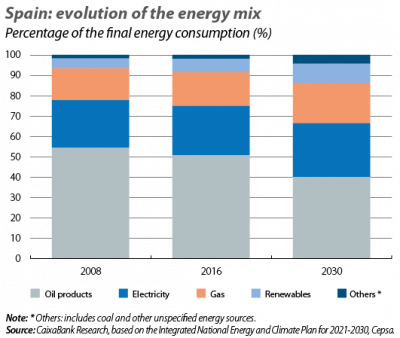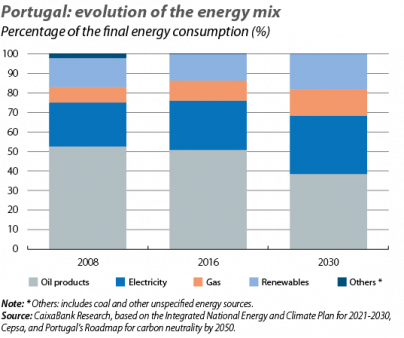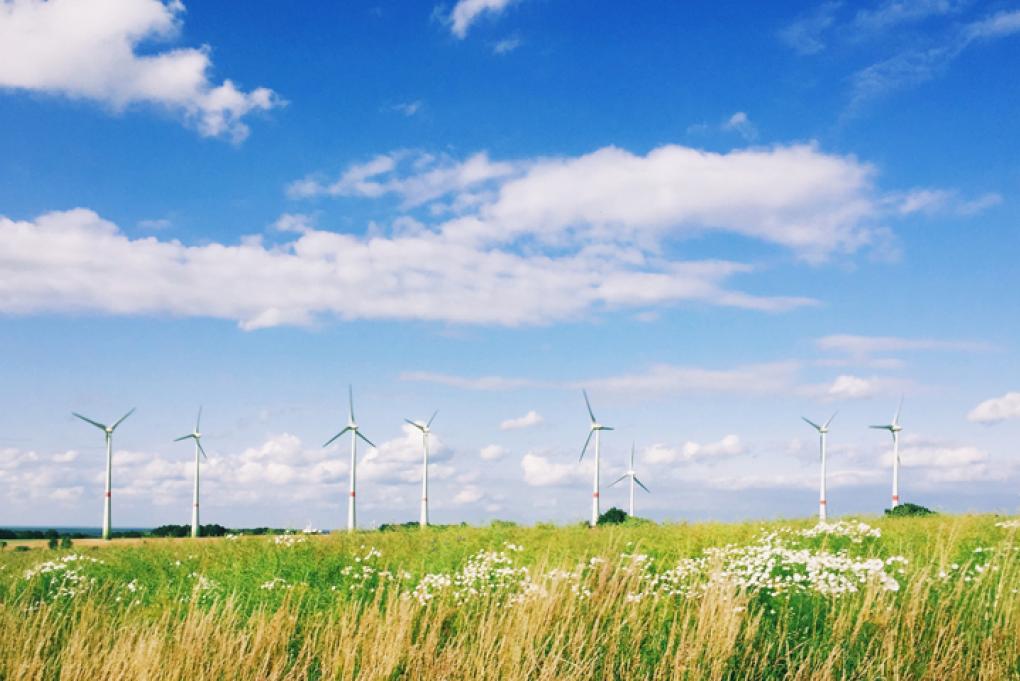The new energy mix in the Iberian Peninsula: the fight against global warming
In January 2019, the Mauna Loa observatory in Hawaii recorded the highest ever level of carbon dioxide concentration in the atmosphere, of 411 parts per million (ppm), compared to 290 ppm recorded in 1880. In addition, in 2018 the temperature of the planet’s surface exceeded the average temperature recorded between 1951 and 1980 by 0.8ºC.1 Experts highlight the adverse effects that greenhouse gas emissions, primarily caused by human activity, have on our planet and the urgency with which action should be taken, particularly through changing the energy sources on which we base our consumption. In this context, what is the position of the Iberian Peninsula and what can we expect in the future?
The current energy context in the Iberian Peninsula
Currently, primary energy production2 in Spain and Portugal is based, essentially, on renewable energy, with solid biofuels topping the list in both cases, followed by wind energy. In addition, primary energy production in both countries is substantially lower than the primary energy consumption3 (with a ratio of 27.2% in Spain and of 22.9% in Portugal in 2017, compared to the EU average of 48.6%). Although the ratio remains well below the EU average, the two economies have experienced an improvement in the last 10 years, due to the increase in primary energy production and the decline in primary consumption over this period, a signal that we are moving towards a more sustainable model.4
As the energy needs in both Spain and Portugal exceed what each country can produce, both of them import much of the energy they consume. In both cases, oil and oil products play a particularly important role, accounting for over 65% of their total energy imports. These are followed by natural gas and coal.
The final energy consumption5 in Spain and Portugal, meanwhile, is led by oil products, accounting for around 50% of the total (40% in the EU), as can be seen in the charts. This can be explained by the weight of industry and transports in the final energy consumption (together, they represent more than 65% of the total final consumption).6 Electricity holds the second position in the energy mix of the two countries, accounting for over 20% of the total, although the sources of energy used in domestic electricity production differ between the two countries.7 In third position in Spain is natural gas, accounting for 17% (10% in the case of Portugal). In Portugal, on the other hand, the third source of energy is renewables (13% of the final energy consumption, versus 7% in Spain).
What to expect in the next decade?
The concern over environmental issues will define the next 10 years. In fact, as explained in the article «Green finance in focus» in this same Dossier, the Paris Agreement, signed in 2015, seeks to limit the average increase in global temperatures to 2oC above pre-industrial levels and to accelerate efforts to limit the increase to 1.5oC. Following on from this, the EU committed to reduce greenhouse gases by 40% by 2030, compared to 1990 levels. In this context, Spain must commit to a minimum reduction of 20%, and Portugal to a reduction of between 20% and 35% compared to 1990 levels. To achieve this, there will need to be a reduction in greenhouse gases caused by the energy sector, which is largely responsible for their emission into the atmosphere. In turn, and if it is seen through, this transformation will have a significant impact on the economies of the Iberian Peninsula from the point of view of energy dependency.8 In fact, in 2016, the energy dependency of Spain was 71.9%, and 73.5% in Portugal (EU average, 53.6%).9
Both countries expect to reduce their net greenhouse gas emissions to 0 by 2050. In this regard, both national energy plans anticipate a significant reduction in the role of oil and oil products in the energy mix between now and 2030 (–11.0 pps in Spain and Portugal, compared to 2016), following the relatively modest reductions observed in the last decade (–4.0 pps in Spain and –3.0 pps in Portugal). However, oil products are expected to continue to lead the energy mix in both countries and to represent 40% and 39% of the final energy consumption in Spain and Portugal, respectively. This leadership will be due to the weight of the transport sector, which is highly dependent on oil products. Therefore, if the authorities want to reduce the weight of oil in the energy mix, they should encourage the replacement of fossil fuels for electricity, biofuels or hydrogen.
At the same time, there will be a relatively modest increase in the weight of electricity in the energy mix between now and 2030 (2.0 pps in Spain and 5.0 pps in Portugal, compared to 2016) and, in turn, this trend will encourage greater use of renewable resources. In fact, both countries have clear objectives in this area: Portugal is aiming for 80% of its electricity production to come from renewable sources by 2030 (solar, wind and hydroelectric power, mainly). Spain, meanwhile, aims to achieve a 74% share (wind, solar and hydroelectric).10 The electrification of the energy mix should take place across the various sectors, but, in the case of industry, the change could be slower than in other sectors, considering the complexity involved in the transformation of business models and the innovation of production processes.
The third main source of energy in the final consumption is expected to remain different in the two countries: in Spain, the projections obtained based on the energy plan and other economic studies suggest that natural gas will continue to occupy the third place, with a weight of 20% in 2030, followed by renewable energies (9%). In contrast, in Portugal renewable sources are expected to retain third position in the energy mix, with 18% of the total. This is not only a result of a very significant increase in the use of these energies between now and 2030, but above all, it is due to the important role that renewables already play in the final energy consumption in Portugal (13% in 2016, compared to 7% in the case of Spain and the EU average) and the substantial investment that the country has made in these resources in recent years.
The change in the energy mix, more geared towards clean energy sources, will have a positive impact not only on the environment, but also on public health and the economy. This change will allow the Iberian economies to reduce their dependency on oil and oil products, and this in turn will reduce the energy bill, thanks to a reduction in imports and, therefore, will contribute to improving the balance of trade.11 At the same time, investment in renewable energy sources will contribute to economic growth and job creation. However, what impact this more sustainable energy mix will have on the cost of energy for the final consumer remains unclear. To a large extent, this will depend on whether technological progress can continue to reduce the cost of producing renewable energy, as has been the case in recent years.
Vânia Duarte
1. According to data from NASA.
2. Primary energy production is the extraction of energy products for use from natural sources.
3. Primary energy consumption includes the consumption of the energy sector, losses occurring in the transformation and distribution of energy, and the consumption of end users.
4. In 2008, the proportion was 19.0% for Portugal and 22.5% for Spain. One of the reasons for the decline in consumption is the financial crisis in this period.
5. Final energy consumption includes the total energy consumed by end users, such as households, industry, services and transports.
6. The remaining 30% corresponds to domestic activities (such as heating), the service sector and agriculture, among others.
7. In Spain, natural gas, renewables and nuclear energy represent 77% of the domestic electricity production. In Portugal, natural gas, renewable energies and coal represent 97% of electricity production.
8. In particular, both countries have a high dependency on oil products and imported oil, with a dependency ratio (measured by the ratio of net imports of oil and oil derivatives compared to the total gross domestic consumption and the oil used in maritime bunkers) of 96.9% and 99.2% for Spain and Portugal, respectively, in 2016.
9. For an in-depth analysis, see the article «The geopolitics of energy» in this same Dossier.
10. Currently, renewables represent 33% and 41% of the total in Spain and Portugal, respectively.
11. Taking into account the Integrated National Energy and Climate Plan for 2021-2030 for Spain and Portugal, the target is to achieve a reduction in the dependency ratio to 59% and 65%, respectively.




